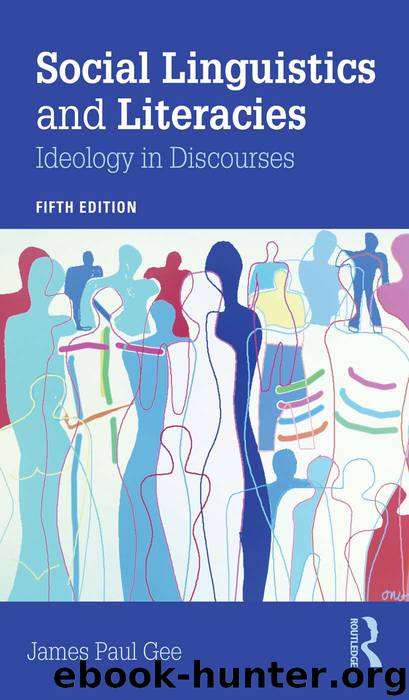Social Linguistics and Literacies by Gee James;

Author:Gee, James;
Language: eng
Format: epub
ISBN: 1975249
Publisher: Taylor and Francis
Chapter 12
Discourse analysis
Stories go to school
Abstract
This chapter deals with the discourse analysis of narratives and stories. It argues that everyday stories very often make deep sense in quite literary ways. The analyses in this chapter stress both a way of engaging in the discourse analysis of stories and a focus on placing stories in their wider social contexts. In particular, the chapter deals with the educational and equity issues that arise at school in terms of the use of language.
Discourse analysis of stories and their contexts
Now I turn to a different genre: stories. I argued in the last chapter that speech is organised into lines and stanzas. Lines and stanzas are, I believe, universal, the products of the mental mechanism by which humans produce speech (Gee 1986, 1989c, 2014a, b). At the same time, how different people organise language within these lines and stanzas is socially and culturally variable (Gee 1989c; Hymes 1981; Scollon and Scollon 1981; Tedlock 1983).
To discuss the role of lines and stanzas in sense-making, I will concentrate on two school ‘sharing-time’ stories by a seven-year-old African-American girl whom I will call ‘Leona’ (not her real name). Because she comes from a culture that has retained substantive ties with an ‘oral-culture’ past (Edwards and Steinkewicz 1990; Rickford and Rickford 2000; Smitherman 1977), Leona’s stories are very rich in ‘literary-like’ markings of discourse structures.
After analysing Leona’s stories, I will discuss why they were not accepted by her teacher as successful sharing-time turns at school. I will also eventually contrast them with a successful sharing-time turn. This will allow us to see the workings of sense-making in social contexts, with all their political and ideological ramifications.
I reprint the two stories below. But before preceding further, let me say something more about how the transcripts of these two stories were prepared. All speech is produced in ‘little spurts’ which the linguist Wallace Chafe has called ‘idea units’ (Chafe 1980, 1994). Each spurt has a unitary intonation contour and is often bounded by short pauses or hesitations.
For Chafe (1980) an idea unit is a single focus of consciousness, analogous to the single focus of the eye as it scans a scene through many rapid focuses. The vast majority of these idea units are a single clause, with one piece of new information towards the end of the clause. It is only when the subject of the clause, or an adverbial element, is new information that it constitutes an idea unit by itself (this is a simplification, see Chafe 1994). Some examples of idea units taken from the stories printed below are (each idea unit is printed on a separate line):
today
it’s Friday the 13th
an’ … my mother
my mother
my mother’s bakin’ a cake
last night
my grandmother snuck out
my puppy
he always be following me
Once the agent or an adverbial element is introduced as an idea unit, the speaker can then incorporate it as old information in the following idea unit(s). Once this happens, idea units tend to be clauses with an old or given agent and with new information at or towards the end of the clause.
Download
This site does not store any files on its server. We only index and link to content provided by other sites. Please contact the content providers to delete copyright contents if any and email us, we'll remove relevant links or contents immediately.
| Administration | Assessment |
| Educational Psychology | Experimental Methods |
| History | Language Experience Approach |
| Philosophy & Social Aspects | Reform & Policy |
| Research |
The Art of Coaching Workbook by Elena Aguilar(48065)
Trainspotting by Irvine Welsh(20055)
Twilight of the Idols With the Antichrist and Ecce Homo by Friedrich Nietzsche(17706)
Fangirl by Rainbow Rowell(7834)
Periodization Training for Sports by Tudor Bompa(7328)
Change Your Questions, Change Your Life by Marilee Adams(6641)
This Is How You Lose Her by Junot Diaz(5773)
Grit by Angela Duckworth(4738)
Red Sparrow by Jason Matthews(4667)
Asking the Right Questions: A Guide to Critical Thinking by M. Neil Browne & Stuart M. Keeley(4576)
Paper Towns by Green John(4169)
Room 212 by Kate Stewart(4107)
Ken Follett - World without end by Ken Follett(3972)
The Sports Rules Book by Human Kinetics(3588)
Housekeeping by Marilynne Robinson(3401)
The Motorcycle Diaries by Ernesto Che Guevara(3332)
Introduction to Kinesiology by Shirl J. Hoffman(3301)
Exercise Technique Manual for Resistance Training by National Strength & Conditioning Association(3292)
Double Down (Diary of a Wimpy Kid Book 11) by Jeff Kinney(3273)
